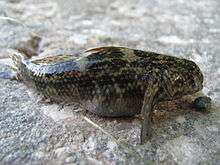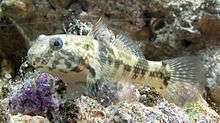Frillfin goby
| Frillfin goby | |
|---|---|
 | |
 | |
| Scientific classification | |
| Kingdom: | Animalia |
| Phylum: | Chordata |
| Class: | Actinopterygii |
| Order: | Gobiiformes |
| Family: | Gobiidae |
| Genus: | Bathygobius |
| Species: | B. soporator |
| Binomial name | |
| Bathygobius soporator (Valenciennes, 1837) | |
| Synonyms | |
| |
The frillfin goby (Bathygobius soporator) is a species of marine fish in the genus Bathygobius.[2]
Description
The frillfin goby is a usually dark colored goby with mottled coloring of black, gray, and tan, but body color is variable between habitats. It has a thin, gray-green first dorsal fin and a trailing second dorsal fin of the same color. Its brown eyes are proportionally large. Its cheeks are large. The caudal, anal, pectoral, and pelvic fins are a transparent yellow. The pelvic fins of the frillfin goby has one spine and five rays that are close together.[3]
Diet
The frillfin goby feeds on small crustaceans, like copepods, and small fishes like the tilapia fry. The frillfin can also feed on insects, detritus, bivalves, and gastropods.[4]
Habitat
Individuals are often found in tide pools, around mangrove trees, or in sheltered seagrass beds.[5] The Frillfin goby can be found in marine, brackish, and even freshwater, and it can tolerate a wide range of salinities.[6]
Reproduction and lifecycle
The female goby lays her fertilized eggs on a hard, sheltered surface, such as the inside of an empty conch shell. The male can mate with several females, and each mate lays her eggs in a single location. The cluster is then protected by the male until the eggs hatch. These males are often extremely territorial, and chase off intruders. The young gobies can grow to an average of about 7.5 cm in length.[7]
Distribution
This species is found in the Gulf of Mexico. It prefers inshore shallows especially near rocks and pilings.
Importance to humans
Although rare, the frillfin goby has been seen in the aquarium trade.[8]
References
- ↑ van Tassell, J.; Tornabene, L.; Pezold, F.; Aiken, K.A. & Bouchereau, J.-L. (2015). "Bathygobius soporator". The IUCN Red List of Threatened Species. 2015: e.T183177A1731074. Retrieved 22 August 2018.
- ↑ http://www.marinespecies.org/aphia.php?p=taxdetails&id=277638
- ↑ "Bathygobius soporator". www.sms.si.edu. Retrieved 2017-05-01.
- ↑ "Bathygobius soporator (Frillfin Goby, Molly Miller)". www.iucnredlist.org. Retrieved 2017-05-01.
- ↑ "Bathygobius soporator". www.sms.si.edu. Retrieved 2017-05-01.
- ↑ "Bathygobius soporator (Frillfin Goby, Molly Miller)". www.iucnredlist.org. Retrieved 2017-05-01.
- ↑ "Bathygobius soporator". www.sms.si.edu. Retrieved 2017-05-01.
- ↑ "Bathygobius soporator (Frillfin Goby, Molly Miller)". www.iucnredlist.org. Retrieved 2017-05-01.
